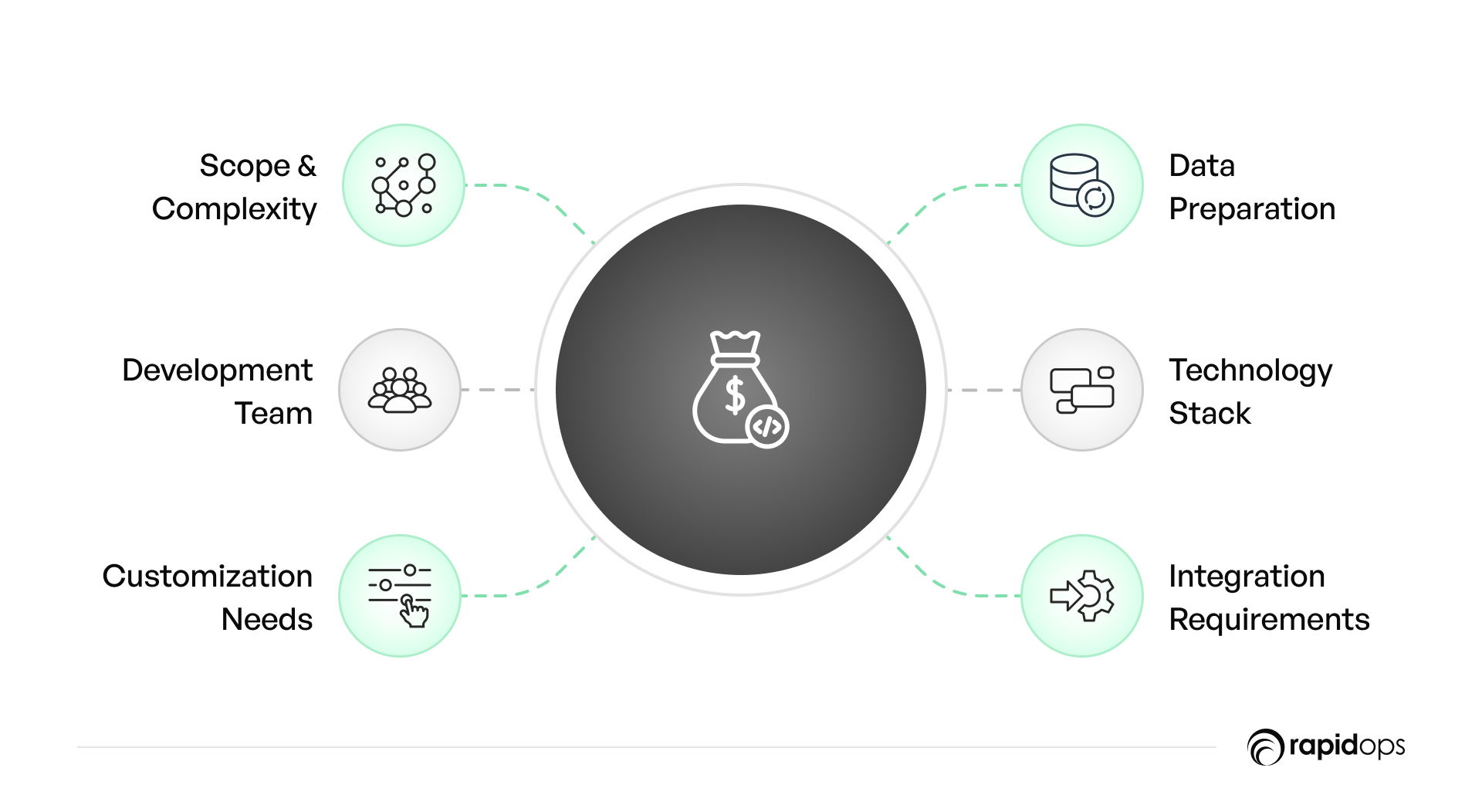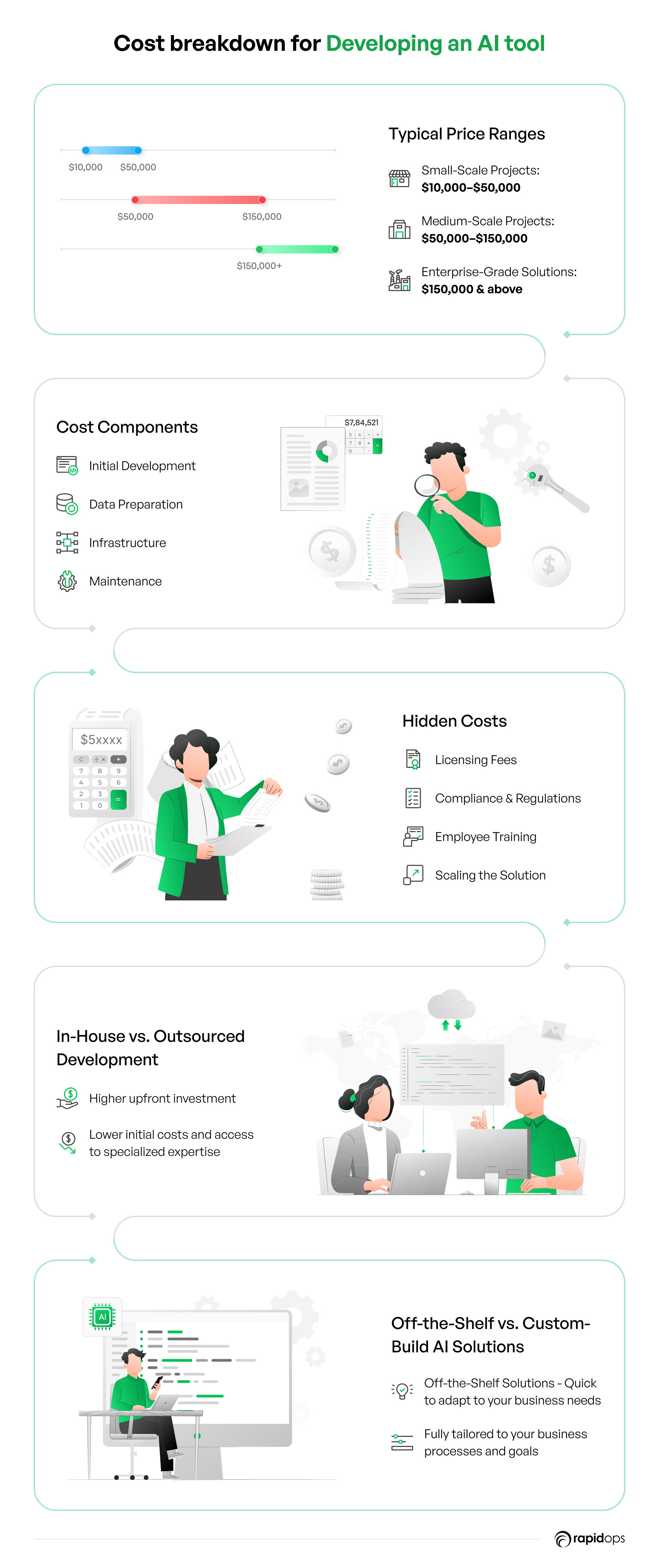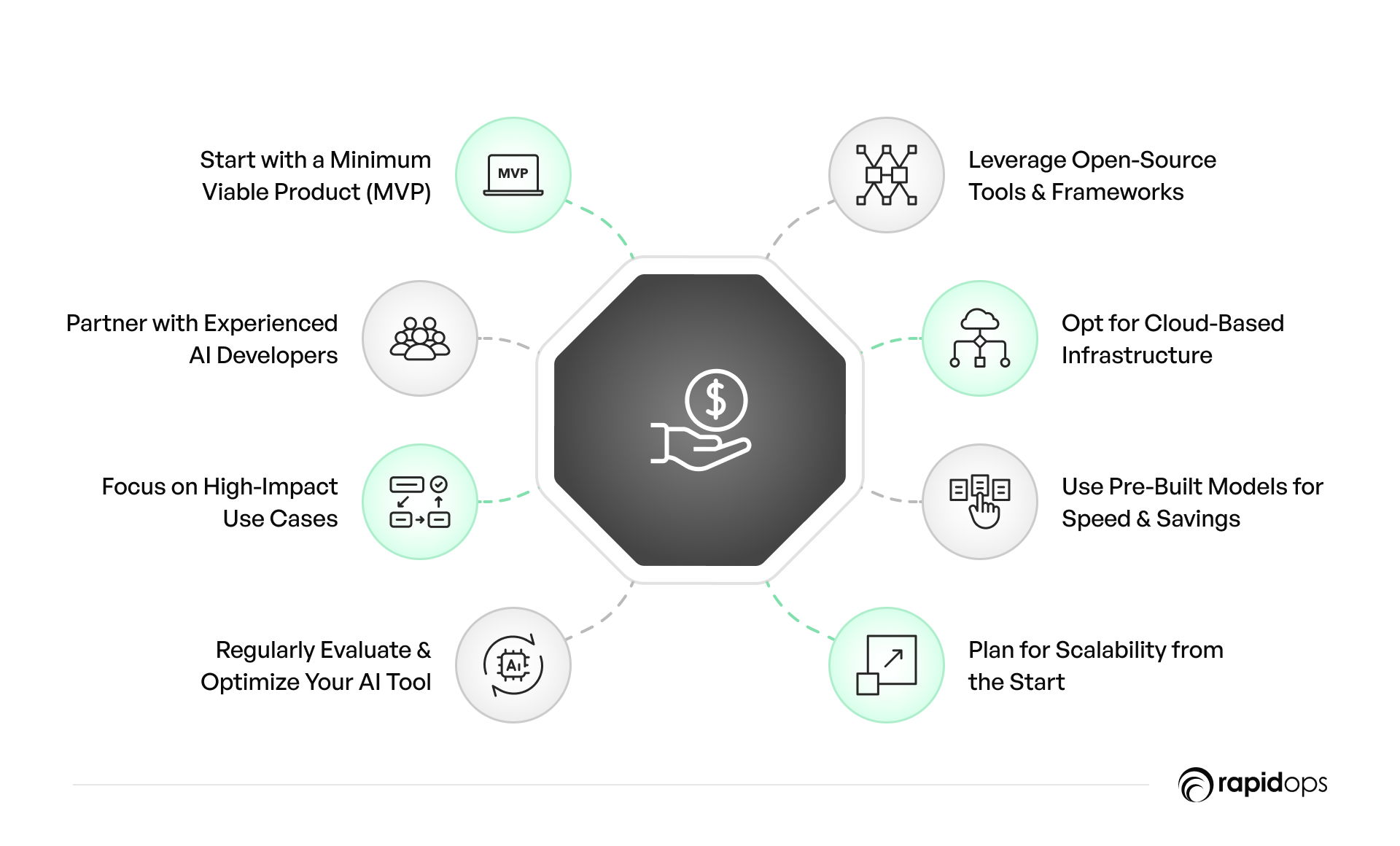The question isn’t about the importance of AI; it’s about feasibility:
- How much does it actually cost to develop a custom AI solution?
- What factors determine these costs?
- And how can you plan for AI adoption without unnecessary overspending?
In this blog, we’ll dive straight into the numbers and the nuances, breaking down the real costs of developing AI solutions.
We’ll demystify not just the AI development cost, but also offer clarity on ongoing AI cost implications. We’ll also provide actionable insights to help you approach this investment strategically, ensuring alignment with your business goals and operational realities. But beyond interest, many leaders are left wondering: how much does AI cost to implement for their unique needs?
Because, understanding the AI development cost early on helps prevent surprises during budgeting and ensures alignment with your financial expectations.
Factors that influence the cost of AI development

When considering AI development for your business, understanding the variables that impact costs is critical. AI solutions are not one-size-fits-all; their costs are shaped by the unique needs of your industry and goals. Let’s delve into the key factors driving these costs and how they align with business priorities.
1. Scope and complexity
The scope of your AI project significantly impacts the cost. Are you building a simple chatbot for customer service, or a sophisticated predictive analytics tool to streamline supply chain operations?
The answer to how much does AI cost often begins with project scope.
- Small-scale projects like chatbots or single-feature tools are relatively straightforward and cost-effective. Such tools generally have a lower AI development cost due to limited model training and narrow use cases.
- Enterprise-grade solutions involving advanced machine learning models or real-time processing are far more complex and costly.
This distinction is crucial because AI development cost scales rapidly with increased functionality and system interconnectivity. Understanding AI pricing at this stage helps avoid feature creep and scope drift.
2. Data preparation
AI thrives on data, but the preparation process can be time-consuming and expensive. Most teams underestimate how much does AI cost when factoring in raw data challenges. In fact, data readiness alone can represent a large chunk of the AI development cost, especially in data-rich environments like retail or manufacturing.
- Data collection and cleaning: Collecting high-quality data and ensuring it’s clean, structured, and relevant requires specialized tools and expertise. This step is often underestimated when calculating total AI development cost.
- Labeling: For supervised learning models, datasets often need to be labeled, which may involve manual or automated processes. Manual labeling inflates both AI cost and time-to-market, especially in regulated sectors.
- Storage: Storing large datasets securely, whether on-premise or in the cloud, adds another layer of cost. The choice between on-premise and cloud storage also impacts long-term AI pricing.
3. Development team
Building an AI tool requires a multidisciplinary team with diverse expertise. Labor accounts for a major portion of AI development cost, especially when engaging highly specialized experts, such as:
- Data scientists: Responsible for designing and fine-tuning the AI algorithms that form the foundation of your tool.
- Machine Learning (ML) engineers: Focused on implementing and optimizing machine learning models, ensuring they are production-ready and scalable. ML engineers play a crucial role, and their cost contribution forms a big chunk of your total AI cost.
- Data engineers: Handle the processing, transformation, and structuring of large datasets, ensuring the AI tool has access to clean, reliable data.
- Software developers: Code the application and integrate it seamlessly into your existing systems, such as ERP or CRM platforms.
- Project managers: Oversee timelines, budgets, and deliverables, ensuring alignment with your business objectives. Skilled PMs can help reduce bloated AI pricing through efficient task planning and budget control.
The cost also varies depending on whether you hire an in-house team or outsource to an experienced AI development firm. Before hiring, businesses often need to ask: how much does AI cost when building internally versus outsourcing?
4. Technology stack
The technology and tools you choose also play a crucial role in the overall expense. The tech stack selection has a direct impact on your AI development cost, from licensing to ongoing operational scalability.
- Platforms like AWS, Azure, or Google Cloud provide scalable and flexible solutions but come with usage fees. AI pricing on cloud platforms is consumption-based, and spikes can occur without clear usage benchmarks.
- Advanced tools like TensorFlow, PyTorch, and proprietary software may require licensing costs. Licensing models can make you rethink how much does AI cost over time versus upfront.
- If you’re developing on-premise, infrastructure investments (e.g., servers) can further increase costs.
Your technology decisions affect not just AI development cost, but also recurring AI cost and flexibility.
5. Customization needs
The level of customization your AI tool requires is a key factor influencing development costs. While building an AI solution, the degree of customization directly correlates with its complexity, scalability, and future adaptability.
Highly modular setups often drive up how much does AI cost initially, but yield better agility over time.
Highly customizable tools
If your AI tool is designed to evolve alongside your business, it will require a higher degree of customization. This includes features like modular architecture, integration flexibility, and scalability to accommodate new use cases or growing data demands. Naturally, a higher degree of adaptability means a higher AI development cost upfront, although it pays off long-term.
Example: A predictive analytics tool for manufacturing that integrates seamlessly with supply chain systems and can adapt to real-time data streams. These scalable systems come with a higher AI cost due to continuous adaptation and maintenance.
Cost implication: Greater customization requires additional development time, advanced engineering expertise, and robust testing to ensure flexibility and scalability.
Specific-use AI solutions
For businesses with clearly defined, static needs, the customization required may be limited to solving a particular problem.
Example: An AI-driven visual quality inspection tool designed to detect defects in a production line. Targeted tools offer predictable AI pricing, but risk obsolescence as business needs evolve.
Cost implication: While less customizable solutions are more cost-effective initially, they may require redesigning or additional development to accommodate future business changes.
Building a highly customizable tool may involve a higher initial investment, but it ensures your AI solution can grow with your business, reducing the need for costly overhauls later.
6. Integration requirements
Most businesses already have systems like ERP, CRM, or supply chain software in place.
- Seamless integration: Developing AI that works smoothly with existing systems can involve additional development and testing costs.
- Example: For a distribution company, integrating AI-powered demand forecasting with inventory and logistics software requires careful system compatibility assessments and API development.
Businesses must assess early how much does AI cost to integrate with legacy or cloud-based ERP systems. Consider integration requirements early in the planning phase to avoid unexpected delays or costs during implementation. Deep integration work can dramatically alter AI cost and even AI pricing models.
7. Scaling the solution
As your business grows, your AI tool must evolve to handle larger datasets, more users, and increased complexity. Planning for scalability during the development phase can help minimize future costs and disruptions.
Data growth
As businesses in industries like retail and distribution grow, the volume of data they generate and process increases exponentially. Scaling AI to process this data efficiently often requires upgrading infrastructure and refining models.
Example: A retail AI tool predicting customer preferences may need to process larger data sets as customer bases and product lines expand.
User expansion
Scaling AI tools for additional users or operational touchpoints, such as multiple warehouses or manufacturing sites, can lead to increased resource demands. Multi-site deployment introduces complexity and increases AI cost significantly if unplanned.
Example: A manufacturing AI tool initially designed for one plant may require additional development to optimize performance across multiple facilities.
Cost implications
- Upgrading hardware (e.g., cloud computing resources).
- Refining machine learning models to ensure accuracy with larger datasets.
- Optimized models can balance performance and AI pricing as user loads increase.
- Expanding integrations with new systems or databases.
- Anticipating future growth in user and data volume helps in accurately forecasting the AI development cost.
Choose a scalable architecture during development to accommodate growth with minimal reengineering. This proactive approach reduces long-term costs and ensures your AI solution continues to deliver value as your business expands.
Cost breakdown for developing an AI tool

AI development costs can vary significantly depending on the project’s scope, complexity, and requirements. Here’s a detailed breakdown to help you understand where your investment will go:
1. Typical price ranges
To give you better clarity on expected AI development cost, here’s a breakdown based on complexity:
Small-Scale Projects: $10,000–$50,000
Examples: Chatbots, recommendation systems for small eCommerce stores.
Medium-Scale Projects: $50,000–$150,000
Examples: Predictive analytics for inventory management, customer segmentation tools.
Enterprise-Grade Solutions: $150,000 and above
Examples: Real-time supply chain optimization, AI-powered quality control systems in manufacturing.
2. Cost components
Breaking down the costs provides a clearer picture of what you’re paying for:
- Initial development: Designing, coding, and testing the AI tool. This is often the largest single expense.
- Data preparation: Includes data collection, cleaning, labeling, and storage costs.
- Infrastructure: Cloud-based services (e.g., AWS, Azure) typically charge based on usage, while on-premise solutions may require significant upfront hardware investments.
- Maintenance: Post-deployment costs include regular updates, retraining models as data changes, and troubleshooting.
AI development cost also includes environment testing and DevOps workflows for deployment readiness.
3. Hidden costs
Beyond the obvious expenses, there are often hidden costs associated with AI development:
- Licensing fees: Many AI tools or libraries require licenses, adding ongoing costs.
- Compliance and regulations: Especially in industries like retail or distribution, meeting data privacy standards (e.g., GDPR) can involve extra costs.
Ignoring these hidden contributors can lead to a serious underestimation of your AI development cost.
4. In-house vs. outsourced development
Another important decision impacting costs is whether to develop the AI tool in-house or outsource it.
- In-house development: Higher upfront investment (hiring, infrastructure) but provides greater control.
- Outsourced development: Lower initial costs and access to specialized expertise, but may involve higher long-term costs for updates or additional customization.
Tips for cost-efficient AI development

Developing an AI tool doesn’t have to drain your budget. With strategic planning and informed decisions, you can significantly reduce costs while achieving your business goals. Here are practical tips to help you manage costs effectively:
1. Start with a Minimum Viable Product (MVP)
Begin by building a simplified version of your AI tool that addresses one specific business problem. This approach helps in reducing your AI development cost at the initial stage, while validating performance and ROI.
Example: Instead of developing a full-scale predictive analytics system, start with a model that forecasts sales for a single product line.
Benefits:
- Reduces initial costs.
- Allows you to test and validate the tool’s functionality before scaling.
2. Leverage open-source tools and frameworks
Use open-source AI libraries like TensorFlow, PyTorch, or Scikit-learn to avoid licensing fees.
Many open-source tools offer robust capabilities that can meet most business requirements.
Benefits:
- Significantly lower development costs.
- Provides flexibility for customization.
3. Partner with experienced AI developers
Collaborating with developers or agencies with proven expertise in your industry is critical to the success of your AI project. An experienced partner not only brings technical skills but also a track record of building successful AI tools tailored to real-world business needs.
For instance, a firm that has developed predictive analytics for manufacturing or recommendation engines for retail can bring valuable insights and proven methodologies to your project.
The right partner offers end-to-end expertise, covering everything from initial consultation and data preparation to development and deployment. This ensures a seamless process and reduces the likelihood of errors or delays. By choosing a team with deep industry knowledge, you can ensure that your AI solution is both efficient and scalable, aligning with your business goals now and in the future.
An experienced development partner helps streamline the process and optimize your AI development cost by avoiding rework and inefficiencies.
Benefits:
- Ensures faster development and fewer errors.
- Leverages proven strategies and industry-specific insights.
4. Opt for cloud-based infrastructure
Cloud platforms like AWS, Google Cloud, or Microsoft Azure allow you to pay only for what you use, eliminating the need for expensive on-premise hardware. Cloud-native tools not only offer agility but help lower your AI development cost by eliminating hardware and maintenance overheads.
Benefits:
- Low upfront costs.
- Scalability to handle growing data and user requirements.
5. Focus on high-impact use cases
Prioritize AI solutions that deliver measurable ROI.
Example: In retail, a dynamic pricing tool that increases sales might offer a quicker return on investment than an advanced AI chatbot.
Benefits:
- Maximizes value for your investment
- Avoids unnecessary spending on low-priority features.
6. Use pre-built models for speed and savings
Pre-trained models can serve as a strong foundation for developing your AI solution, especially when speed and cost are priorities. However, their effectiveness often depends on your business goals. If your aim is to innovate and gain a competitive edge, pre-built models may require significant customization to align with your unique needs.
Example: Start with a pre-trained natural language processing (NLP) model for a customer service chatbot and tailor it to handle industry-specific queries.
Benefits:
- Speeds up development by providing a ready-made framework.
- Reduces initial development costs while allowing for further customization.
7. Regularly evaluate and optimize your AI tool
Once deployed, continuously monitor your AI solution to ensure it delivers the desired results. Retrain models only when necessary to save resources.
Benefits:
- Avoids overspending on maintenance.
- Improves efficiency and longevity of the tool.
8. Plan for scalability from the start
Design your AI solution to handle future growth without major overhauls.
Example: Choose a cloud platform that can scale seamlessly as your business expands.
Benefits:
- Saves costs associated with reengineering.
- Ensures long-term viability.
By adopting these cost-efficient strategies, businesses can develop AI tools that align with their budgets while delivering high impact.
Concluding thoughts
Developing an AI tool is a strategic investment that can transform how your business operates—whether by enhancing customer experiences, optimizing processes, or driving efficiency.
While the cost of AI development depends on multiple factors, such as project scope, data preparation, and technology choices, careful planning, and cost-efficient strategies can make it a highly rewarding endeavor.
By focusing on high-impact use cases, leveraging open-source tools, and collaborating with experienced developers, businesses in retail, manufacturing, and distribution can achieve scalable, ROI-driven AI solutions without overspending.
At Rapidops, we understand that embracing AI alone isn’t enough. Businesses need secure, scalable, and customized solutions to truly unlock AI’s potential. That’s why we specialize in developing next-gen AI systems that are tailored to your industry, market, and existing infrastructure. From AI-driven automation and machine learning analytics to predictive modeling and natural language processing, our solutions are designed to empower businesses to automate, optimize, and innovate like never before.
With our end-to-end expertise, we’ve helped businesses across retail, manufacturing, and distribution leverage AI to elevate customer experiences, boost operational efficiency, and uncover actionable insights from their data. Our security-first approach ensures that every solution we develop is not only powerful but also dependable, helping businesses scale smarter while managing risks proactively.
Wondering how much it would cost to develop an AI solution tailored to your business needs? Or unsure about the kind of tool that’s right for you?
Schedule a free consultation call with our experts today!
We’ll help you estimate the exact cost and design a solution that aligns perfectly with your goals and budget.
What factors determine the cost of developing an AI tool for my business?
The cost depends on project scope, data preparation, technology stack, and the level of customization required for your business needs.
How long does it take to develop a custom AI solution?
Development time varies but typically ranges from a few months for small-scale tools to a year or more for complex, enterprise-grade solutions.
Is it more cost-effective to develop an AI tool in-house or outsource it?
Outsourcing is often more cost-effective for businesses without AI expertise, while in-house development provides greater control but requires significant investment in hiring and training.
What is the difference between pre-trained AI models and custom AI solutions?
Pre-trained models are cost-effective and faster to deploy but may require customization to fit your needs, while custom solutions offer flexibility and a competitive edge.
How can I ensure my AI tool scales with my business growth?
Plan for scalability during development by choosing a modular architecture, cloud-based infrastructure, and models that can handle growing data and user demands.
How do I estimate the ROI of an AI tool for my business?
Assess ROI by analyzing cost savings, efficiency improvements, revenue growth, and the long-term value of enhanced decision-making capabilities.

Saptarshi Das
Content Editor
9+ years of expertise in content marketing, SEO, and SERP research. Creates informative, engaging content to achieve marketing goals. Empathetic approach and deep understanding of target audience needs. Expert in SEO optimization for maximum visibility. Your ideal content marketing strategist.

Let’s build the next big thing!
Share your ideas and vision with us to explore your digital opportunities
Similar Stories
- AI
- 4 Mins
- September 2022

- AI
- 9 Mins
- January 2023


Receive articles like this in your mailbox
Sign up to get weekly insights & inspiration in your inbox.

